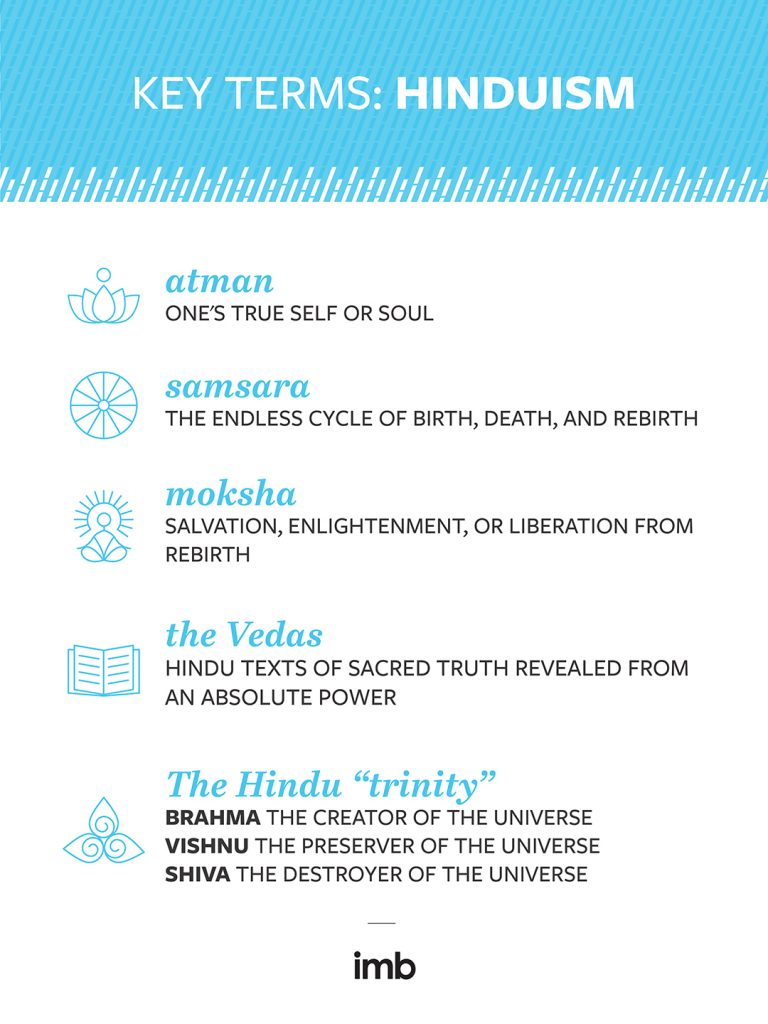 Mahatma Gandhi, the famous nonviolent Hindu reformer, explained that Hinduism is not an exclusive religion. Gandhi said, “If a man reaches the heart of his own religion, he has reached the heart of the others too. There is only one God, and there are many paths to him.” Although some ideas unify Hinduism, it is an extremely tolerant religion that allows its followers full freedom to choose their own belief system and way of life.
Mahatma Gandhi, the famous nonviolent Hindu reformer, explained that Hinduism is not an exclusive religion. Gandhi said, “If a man reaches the heart of his own religion, he has reached the heart of the others too. There is only one God, and there are many paths to him.” Although some ideas unify Hinduism, it is an extremely tolerant religion that allows its followers full freedom to choose their own belief system and way of life.
It’s rare that two Hindus believe exactly the same thing. What follows is a general summary of Hinduism, but it’s always best to ask individuals what they personally believe.
What Do Hindus Believe about God?
Hinduism has traditionally been considered polytheistic—the worship of many gods—but may better be described as henotheistic—the worship of one particular god without disbelieving in the existence of others. Hinduism recognizes up to 333 million gods, but many Hindus believe this vast number represents the infinite forms of god—god is in everyone, god is in everything.
Many Hindus believe in and worship three gods that make up the Hindu “trinity”: Brahma the creator of the universe, Vishnu the preserver of the universe, and Shiva the destroyer of the universe. These gods, along with the other millions of deities, are considered manifestations of either one supreme god or a single, transcendent power called Brahman (not to be confused with Brahmins, the priestly social class). Many Hindus would even say Jesus was a manifestation of one of their gods.
No matter what form of Hinduism they follow, most Hindus are also active animists. They attempt to appease good and bad spirits by worshiping at auspicious times, studying horoscopes, and wearing amulets to guard against diseases and evil.
Hindu Holy Texts
Many Hindu practices today somewhat rely on the spiritual literature and authority of the Vedas—texts of sacred truth revealed from an absolute power to the inhabitants of northern India. The Sanskrit texts that make up the Vedas were composed and orally transmitted by ancient poets and sages as early as 1700 BC. However, many people neither read, adhere to, nor know how to interpret these holy texts. High-caste Brahmins—members of the priestly social class by birth—have closely guarded knowledge of the Vedas to preserve their dominant position in society. Therefore, many Hindus instead choose to follow family traditions and guidance provided by their spiritual teachers, called gurus.
Salvation According to Hindus
Hindus believe in the soul, or true self, called atman. According to Hindus, the soul goes through reincarnation—a rebirth of the soul into a new body after death. Life, birth, death, and rebirth is an endless cycle called samsara. Rebirth is affected by karma—the result of deeds or actions—in the present life. 
There is no concept of sin in Hinduism as it is perceived in Western thought. Instead, there is the law of karma that says every good thought, word, or deed affects the next life favorably while every bad thought, word, or deed leads to suffering in the next life. The law of karma does not allow for the possibility of forgiveness but only the accumulation of inescapable consequences—good or bad, according to right or wrong action. Karma does not affect a Hindu’s relationship with the universal power, Brahman. Whether a person’s karma is good or bad has no impact on their intrinsic oneness with Brahman.
Individuals are born into a particular caste depending on their actions in the previous life. Good karma leads to rebirth in a higher caste and bad karma to a lower caste. One can only become a member of a different caste through death and rebirth. Eventually, the soul will attain moksha—alternately called salvation, enlightenment, or liberation from rebirth—and become one with the universal power, Brahman.
What Is the Purpose of Life for a Hindu?
Hindus have four specific goals in human life.
- Dharma: pursuing virtuous behavior and fulfilling one’s duty in life
- Artha: pursuing and acquiring success and wealth
- Kama: pursuing pleasure in all its forms
- Moksha: pursuing salvation
The first three goals of human life deal mainly with the quality of life and are very important to Hindus. But moksha is arguably the most significant goal. Hinduism offers at least three paths to pursue moksha: the way of ritual and action, the way of knowledge and meditation, and the way of devotion. Hindus usually prioritize or adopt one path over the others.
The way of ritual and action claims that performing one’s duty in this life is the sacred and moral responsibility of the individual. Each caste has a duty or function that helps to sustain society as a whole. If someone deviates from fulfilling his or her function, it is interpreted as bringing disaster to both the individual and to society. Similar to Buddhism, the way of ritual and action focuses on detachment from desire in order to attain salvation. This path is primarily followed by high-caste Hindus, such as Brahmins.
The way of knowledge and meditation says that humans are trapped in an illusion that keeps us from realizing we are a part of god. When this illusion is dispelled, we will reach salvation by becoming one with the ultimate reality. Followers of this path practice yoga, meditation, and are also encouraged to study philosophy in their pursuit to dispel illusion. Modern-day gurus of this path claim they are god and suggest all of us can be god too. This path is followed mainly by the intellectual elite, and its philosophy has been widely embraced by non-Hindus with New Age beliefs.
The way of devotion is characterized by acts of devotion to one’s personal god in the hopes of receiving mercy and instant salvation. These acts range from ascetic practices, singing hymns, and repeating the name of god (the word om), to pilgrimages and sacrifices. This path is open to all—even low-castes, outcasts, women, and children.
Holy Cows, Vegetarianism, and Yoga
Despite the broad spectrum of faith and practice, Hinduism has several common cultural elements: the veneration of cows, vegetarianism, and yoga.
During the Vedic Period of northern India, the cow was a symbol of wealth and prosperity, as well as one of the animals offered in ritual religious sacrifices. But over time, possibly through the influence of Buddhism and Jainism, animal sacrifices waned, and the cow emerged as a sacred symbol to Hindus. The five products of the cow—milk, curds, butter, urine, and dung—are used in purifying and healing rituals. One popular Hindu god, Krishna, spent his early life as a cowherd, further elevating the status of the cow. In some states of India, there are bans and strict regulations concerning the slaughter of cows and eating of beef.
Many rules concerning food govern a Hindu’s life—when to eat, what to eat, and who can prepare food for whom. The preparation and consumption of food are central to a Hindu’s notion of ritual purity and, ultimately, their liberation from rebirth. Not all Hindus are vegetarians, but vegetarianism is seen as an indicator of purity. Many high-caste Hindus are vegetarians.
In Hinduism, yoga is a discipline to transform the individual and become one with the universal power. It takes many different forms according to the traditions or methods under which it is practiced. At its most basic, yoga consists of a particular set of techniques, usually including meditation, to control the body, the breath, and the mind. The practice of using yoga to alter one’s conscious state and suppress the senses has roots going back to the Vedic Period. By contrast, yoga has become popular in the West as a way to achieve physical and mental fitness.
Learn more about how you can have spiritual conversations with Hindus to introduce the gospel.
Leigh Merryman is a writer for IMB. She serves with her family in Southeast Asia.

